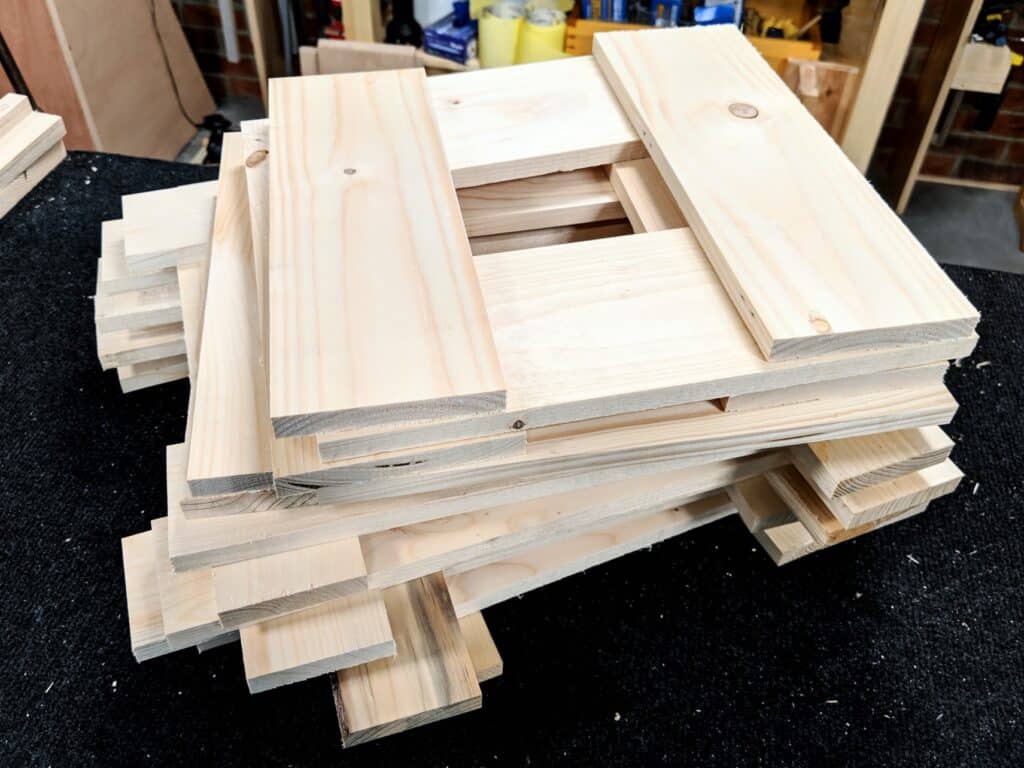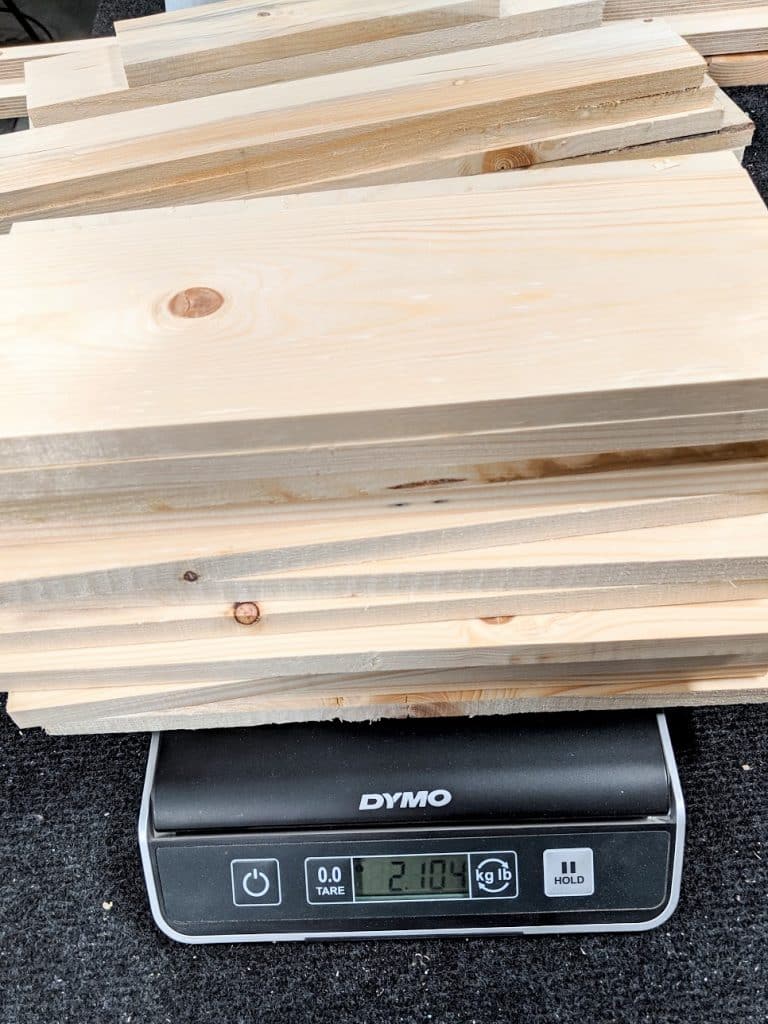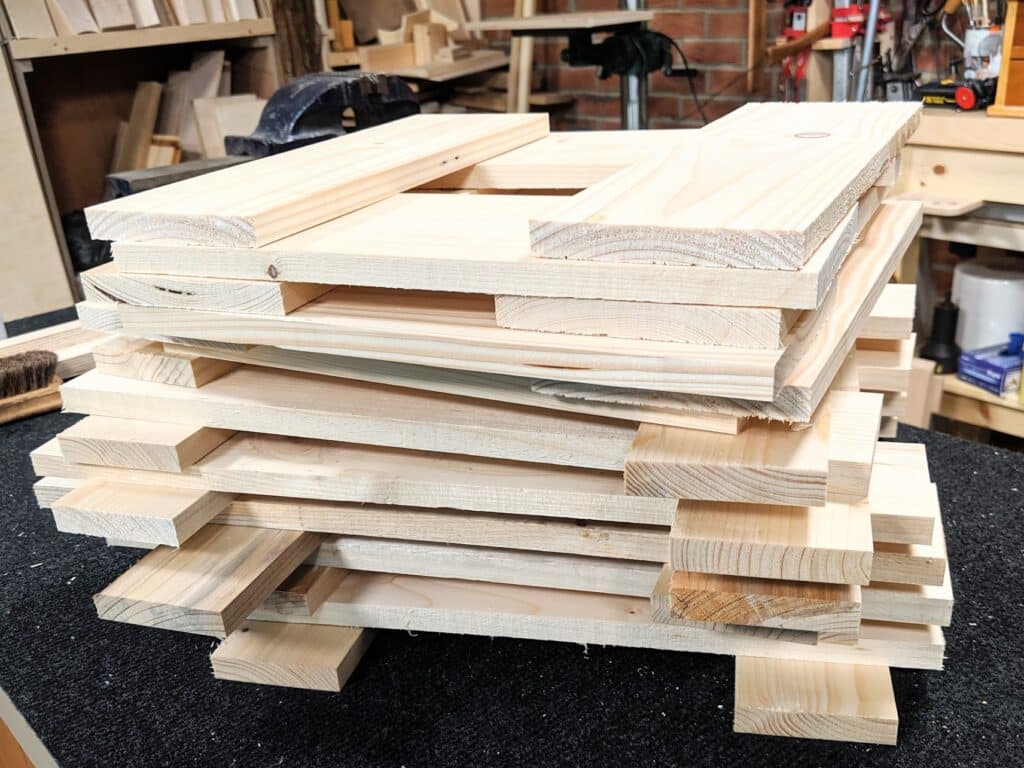A Palletwood Box
Is pallet wood any good? Of course it is. Or at least it can be. Equally it can be bad too, of course it can, but for anyone who just needs to practice, or needs a low cost alternative to gain experience, pallets can be a good resource. Typically pallets are always softwoods. I have had some premium European redwood pine (nothing to do with American redwood) and soft and knotty spruce that seems always to have the hardest knots in the world every two inches apart. Here is the wood from two small pallets. Surprisingly it is very dry wood. How do I know? I check it by weight.

I do have a moisture meter which I generally use as a matter of course. Weighing does guarantee results but requires a little time. By gathering together the pieces and weighing them on some postal scales you can check each day to see that the wood is decreasing in weight.

I say decreasing because most pallets will come from outdoors somewhere so taking them into a drier environment, perhaps with controlled climate, the weight will diminish as the wood releases its moisture naturally. Weighing several pieces, stickering or cross aligning as shown, allows the air to circulate across the faces of the wood too. This speeds up the drying or acclimating process on small sections like this and usually, inside a week or so, the weight loss gets less until it constancy is achieved. The wood from these two small pallets will make several small boxes like my candle box.

Firstly I simply cut out the mid, nail-free sections from the height spacers. It’s quicker and much less troublesome and I don’t want any part with nail holes clenched over anyway. I used the bandsaw but watch out for staples in the edges as these can ruin your bandsaw blade in a heart beat because staples are hardened metal: as hard as a bandsaw blade at least. It’s also good to examine for this before planing too as the staples will play havoc with your plane iron just as well.

Laying out the 30 or so pieces, grouping them according to various considerations, helps me to identify groups according to knottiness, colour, grain configuration and so on. I choose according to how I feel I want the piece to look. Could be complimentary colour to parts, grain effect and so I must have an idea of the look I want otherwise I can end up with nothing looking right at all.

More to come…


My son took delivery of two skids of insulation for his remodeling and I asked him to save the pallets for me. I broke down the Douglas fir pallets about 6 months ago and brought them to my garage where they sat until last month when I made a raised planter for my wife to plant her herbs. The legs are pressure treated as they will be in contact with the dirt and I doubled up the legs to take the weight of the soil. I painted the tips of the legs with FlexSeal for some added protection. The bottom is screened with aluminum screening for drainage and a layer of landscape fabric keeps the soil from washing out.
Here’s a link, if you are interested.
https://photos.app.goo.gl/U2TL4os7PS6HA73P6
First time I practiced laminated boards into a wider board was with pieces of a small pallet. It took me a day I think.. I still have it, it’s a 30 by 40 cm board that I use now to put my laptop on so as not to block the flow from the cooling fan. I’ve always scrounged good and reasonable pallets since, for smaller projects and for general tinkering.. great free resource 🙂
Oh Paul ….that’s a teaser ……”more to come”. Just getting into it with expectations of one of your marvellous pieces produced from timber shown and wallop ……stopped
Rather reminds me of a customer some years ago…..I said “let me lay a nice patio with that pile of brocken slabs”
He replied “oh no……my wife has looked forward to a patio for years, I can’t take that away from her by building one……if I did she can’t look forward to it anymore
haha thanks John, it gave me a chuckle
Alexander. Also gave me a chuckle at the time because I managed to extract enough from the man, with his full approval, to lay a patio for my wife -:)
I wonder how to deal with embedded dirt in the pallet wood. Kind of tough on the tools.
I think I’d just pass it by and look or wait for better.
You could try a high pressure jet washer. I have seen an industrial grade one do amazing things to tree stumps in a free form way. I have found that an electric handheld planer with replaceable tungsten blades skips off the dirty or painted surface 1mm or so which is usually enough with not a lot of effort. Preferably have it connected to an industrial vac if it is paint. If the wood has a few cracks or voids and you are dealing with sand then hand tools are going to need a lot of sharpening because you will never get it all.
Perfect material for making a copy of Gerrit Rietveld’s crate chair.
https://www.instructables.com/id/Gerrit-Rietveld-Crate-Chair/
If you look at industrial and machine pallets, these are often of low to mid quality hardwoods. I have recovered red and white oak, cherry, maple, and hickory. The hardwoods are used to act as padding for the very heavy parts.
The disposable lightweight pallets can often be found left out for passerby in industrial estates. However, the heavyweight returnable ones do belong to someone so ask before taking them. Having your collar felt for a pallet is a bit embarrassing.
I had asked the owner of the electric company shop two years back and he said whenever they are there you’re free to take.
Timely article, Paul. I just took possession of a 6′ long pallet that some home appliance was delivered upon. My co-worker asked if I wanted it. Took a look and saw that it was an Asian ? (I think) white oak of some variety. Nicely dry and beautifully grained. I hand planed a few pieces, liking the wood and the grain, then I used my 12″ planer to dress the surface. Not sure what I’ll make just yet as the slats are roughed in at around 1/2″ x 5″ or 12.7mm x 127mm . The main supports are 1-3/8″ x 48″ or so after nasty screw nail removal. Should be fun to discover the right project. Thanks Paul, for your insight to wood discovery.
The coffee table I made recently had the drawers made from pallet wood.
I use free wood a lot!
Regards,
Matt
Taylor guitar built 25 guitars from pallet wood from the loading dock. They sold for $10,000 each 20+ years ago and here is one of them they asked $15,000 for last year.
Just like with our woodworking, Taylor was trying to prove that success was the skill of the builder as much as the wood.
https://reverb.com/item/11715897-taylor-gallery-series-pallet-guitar-2000-natural
I pull the drawers out of curbside discards and use the sides and bottoms on new work. The new drawer is smaller than the original, of course.
I also started with wood from pallets that I picked up on the beach, took home, shook, swept with a brush, washed and allowed to dry for a few days; I cleaned the wood twice and then used it to learn how to make objects, to make small projects (at that time, for me, they were bigger), swallowtails, sawing, squaring, etc.
I still have some boards and whenever I see abandoned pallets I bring them home and use them.
It was a good start and cheap. Only once did I have to sharpen the planer more often because of the beach sand that was quite entangled in the wood.
Thank you. Best regards.
I can vouch for the havoc to the plane iron. I recently “missed” an embedded nail and the found it as I was planing down. It took a nick right out of the center of my new Woodriver #4. It turned my free lumber into 5 years worth of wear on that plane iron. Looking forward to the “more to come”.
I have a cheap import plane for this kind of purpose. For instance, painted wood with possible brad nails, or dirt/sand. I feel like “not afraid to mess it up” is a valuable feature–in tools and wood. Especially helpful for those like me who feel we are still learning! I feel your pain though, a deep gouge would cause a lot of sharpening… 🙂 cheers
I live in Canada on the prairies where the temp. gets down to – 30C in the winter. I made an arrangement with the local lumberyard to deliver hundreds of wood pallets to my place in the country where I cut them up and burn in my woodstove. It’s a win win situation because these pallets would have just ended up in the land fill, so I take them off there hands and use them to heat my house. Over the years I have recovered some beautiful wood, oak, pine, some species I can’t identify. I made a couple of hollow and round planes from some 4×4 pallet wood which looked like cherry. Love your resourcefulness, great article Paul.
There is an amazing quantity of free wood to be had if you just keep your eyes open. The quality varies but, given some of the rubbish sold by some timber merchants, you can easily do much worse than grabbing freebies!
A friend gives me wooden wine boxes which can be upcycled into tool boxes – a combination plane now lives in a custom made box with ‘St Emillion Premier Cruz’ branded on the side.
There are always houses being renovated near my home and timber (sometimes a century old) is often dumped in skips when replaced by something modern. This old timber has long finished any twisting and significant shrinking and finds its way into my woodpile.
Timber is not the only freebie. A friend recently bagged a 1500 watt pillar drill which had been left beside a recycling bin. Apart from being a bit grubby with surface rust, it was in perfect condition – and would cost a fortune to buy new!
Anything which someone else has discarded is always worth a second look!
I might add, there are all kinds of hardwoods to be found in pallets too. Look out for the more unusually shaped pallets, often from abroad, and often used for transporting pavement slabs, gravel etc. We’ve found all kinds of oak, ash, poplar and a whole array of beautiful exotic hardwoods that are difficult to identify.. The only bother is that the wood is often so dry it is extremely brittle.
I only recently found your blog and YouTube videos, got to say they’re about the most inspiring thing on the internet! Thanks so much for sharing your enthusiasm
Here in California I find pallets made from pine, poplar and oak but mostly from pine or poplar. Free wood just break it down it’s good for making boxes, practice sawing dove tails or what ever you can make from it.